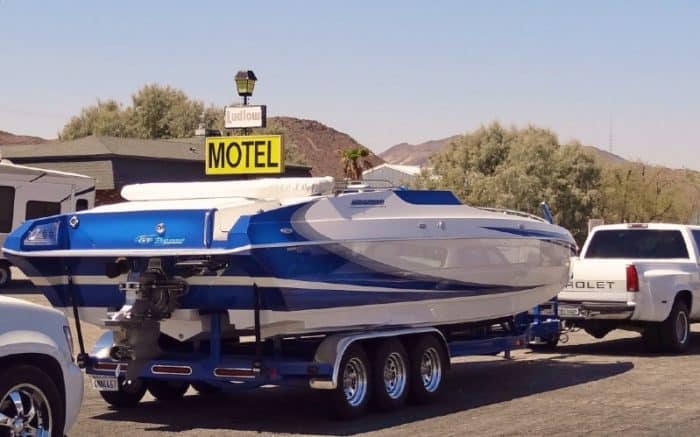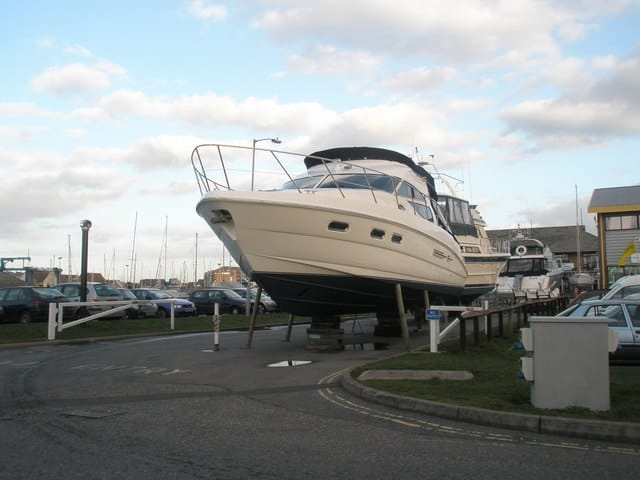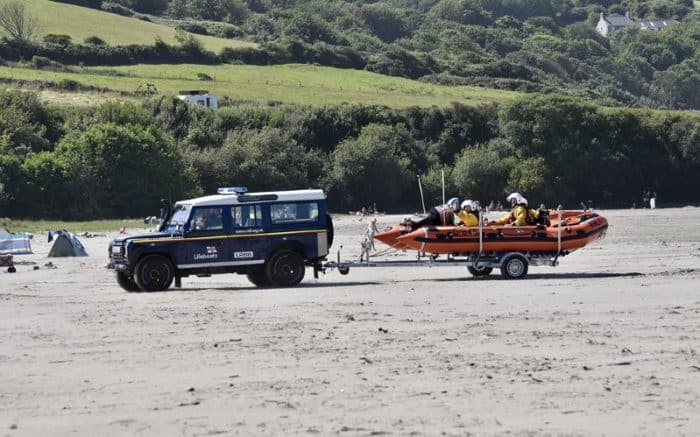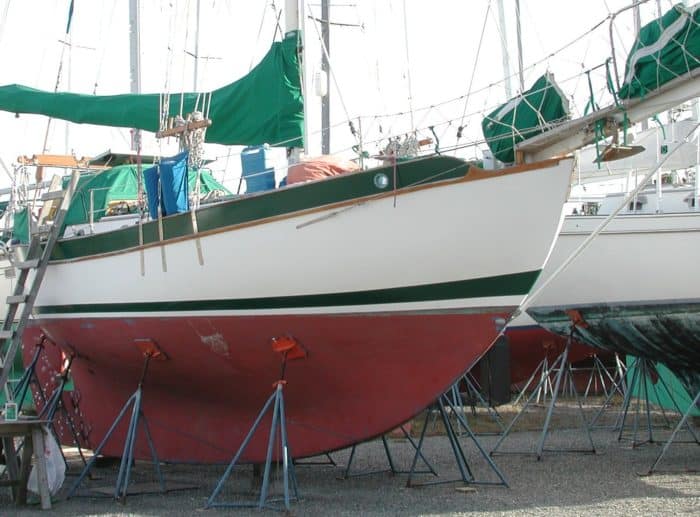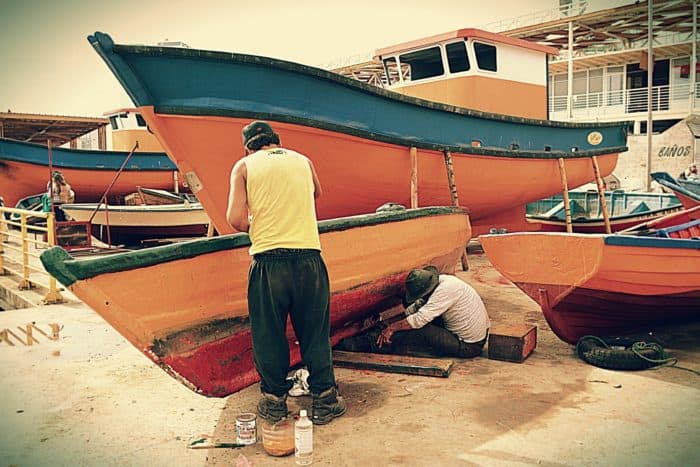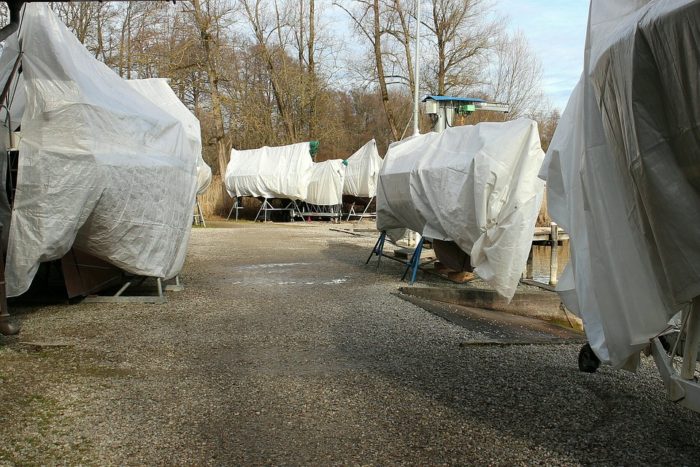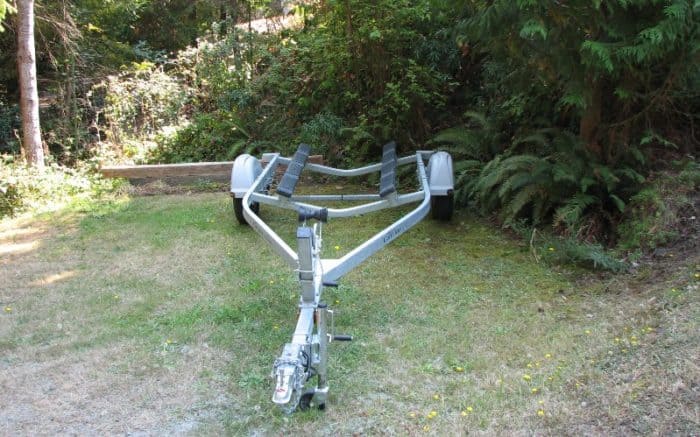How to Jack a Boat Off a Trailer
Every boater who hauls their boat on boat trailers is going to have to get the jacks under the boat and get it off the trailer at some point. You’d be surprised how long some of us can go without doing that, though. The boat goes in and out of the water, on and off the trailer, and that’s it, at least for a lot of people. But there will come a time when you need to get under there. Whether you’re cleaning your boat, looking to bottom paint, or replacing the trailer bunks. Maybe just to swap out trailers, who knows? But what you do need to know is the safest and easiest way to get that boat up with the trailer jacks. Let’s go over the best way to jack your boat off the trailer.
Trailer Jack and Other Things You’ll Need
Always make sure you have the right tools before you begin. We’re going to cover what you need for a boat that’s up to maybe 25 feet in length. Larger boats are a little more cumbersome obviously, and will require more care. You’ll likely need some additional help if you’re looking to move a boat that big. That aside, here is the equipment you want to have on hand.
- Boat stands, sometimes called pop it stands or pipe stands.
- Wooden blocks
- Boat jacks – hydraulic or manual like a bottle jack or floor jack.
- An assistant
- Plywood if jacking the boat up on something like packed dirt or asphalt
Getting a Boat Off Your Boat Trailer
- Before you start you’ll need to consider whether you need plywood planks put down. If you’re going to put your boat up on jacks on a soft surface, use plywood. This means dirt or even asphalt. On a hot summer day, asphalt gets soft and the weight of the boat will push the stand right down into it. You risk the whole thing collapsing, so use the wood as support if needed.
- Block the wheels of your trailer so it can’t move.
- If your boat is covered, undo the straps and remove the cover so there’s nothing in the way.
- You will need to place your jacks at the rear of the boat now. Get the jacks on blocks for support. This can go a couple of ways. If you’re using pop it stands or tube jack stands, you can place one on either side of the boat under the transom. You need to make sure you have it placed properly so that the jacks don’t push through the hull. If you try to lift a boat too far from the transom or with jacks that aren’t properly supported with blocks or planks, this is a very real possibility.
- You can use the jack stands themselves to lift the boat or place a hydraulic jack in the center and use the stands for support after. The hydraulic jack needs to also be properly centered and supported. It all depends on what you have and how you choose to go about it.
- Raise the jacks evenly. If you are using boat jack stands on either side, you should have a partner man one while you man the other. You don’t want to lift one side and then the other side because that can lead to slipping. You want both sides raised as one. You’re looking to lift the boat up enough to see a small space between the hull and the boat trailer bunks in your trailer. As you raise the boat, build up your support blocks right below the strut behind the prop along the center of the boat.
- Raise the boat a little higher than you need to place blocks in the center to make a solid base, then you can lower it just slightly so the blocks take the weight and the stands are there for balance and support.
- If using a hydraulic jack, now you can place boat stands on the port and starboard side in a secure place if the boat is at the right height. Make sure they’re supported with blocks.
- If you used a hydraulic jack, remove it and place wooden blocks where it was. The boat is best supported from the center like this. The stands to port and starboard will balance the boat but the blocks will support it.
- Move to the front of the boat. If you have a clear support strut, you’re going to want to place another jack underneath it here. If you do not have a clear strut you need to find a well-support part of the hull under which you can place the jack.
- Using a hammer, try gently tapping along the hull. Open space will have a higher pitched, hollow sound while a bulkhead will give you kind of a dull thud. It’s a bit like using the tap method to find wall studs. You need to make sure the jack is under a bulkhead or some other sturdy support. Otherwise the jack could very possibly poke a hole in your hull.
- When you find the right spot, you can use a bit of tape to mark it off so you know where to place the jack.
Time to Put the Trailer Jack at the Front of the Boat
- Repeat the same process that you performed at the rear of the boat. With your jack supported on blocks, raise the front of the boat until you see that small gap again between the hull and the trailer bunks. Your boat should now be fully elevated off of the trailer. This should all be taking place with the jack inside the open section at the front of your trailer.
Get the Tow Vehicle Ready
- Remove the blocks from the trailer wheels and have someone start moving the tow vehicle. You should remain at the boat and trailer to give direction. You’ll want to move the trailer forward very slowly and carefully because the jack will be right under the boat and confined within the trailer frame. You can only move the trailer so far before a support cross member will hit the jack and you don’t want to do that.
- Stop the tow vehicle and get a second jack in place, this time on the opposite side of the trailer support cross member from the current jack. The two jacks should be almost side by side with the cross member between them.
- Get the second jack secured in place and then remove the first jack, which will free up the trailer to move forward again.
- Pull the trailer forward again, slowly and carefully, until the rear axle is almost at the second jack. Again, you don’t want to go too fast here. If you knock that jack down it could damage the boat or injure you.
Repeat the Process of Jacking Up the Boat
- Now, once again, place that first jack under the boat behind the axle and jack it up. Then you can remove the second jack you put in place, this freeing up the trailer completely.
- Now you want to place boat stands near the front of the boat on the port and starboard sides. Keep them on blocks and shore them up to offer full support.
- Use boat stand safety chains to ensure extra security. Boat stands should have a slot in then that a chain can be hooked into. Hook the chain into one stand that is secured in place then run it under the boat and hook it into the second stand loosely before the stand is fully adjusted. Then you can tighten up the stand so it fits snugly and increase the tension on the chain until it makes a taut connection to the other stand. This adds stability.
- Start building up the blocks behind the axle the same way you did the blocks at the rear in the center to support the boat’s weight. Once you have your blocks built up high enough and steady enough you can lower and remove the jack. The boat should now be resting front and back on blocks with stands front and back offering support and stability.
- Get the tow vehicle in motion and pull forward, fully releasing the trailer from under the boat. The entire bottom should now be exposed for paint or just to get it on blocks.
- With the trailer fully out of the way, set up large, permanent blocks closer to the front of the boat. You can use the jack stands to lift the boat enough to fit them under snugly, and then lower the boat in place once more. Your boat is now fully supported and free from the trailer. Good job!
Things to Remember
We’ve tried to make the process pretty straight forward here. But do remember that your boat can potentially be very heavy and very unsteady. You need to do this all slowly and very carefully. Balance is extremely important for this to work.
Keep an Eye on Support
Every time you move the trailer forward, pause and circle the boat before moving things again. There are three times you’ll need to move and then stop your trailer before it’s free from under the boat. Each time, circle the boat and check the blocks and stands. You’ll be changing where and how the boat is supported each time. That means there’s potential for it to slip or list to one side. That could mean damage or injury.
The best way to manage this is slow and steady. Take the extra couple of minutes and make sure everything is well balanced and well supported. Adjust the stands as needed to keep it balanced front and back as you remove the trailer.
Watch Your Pressure Points
I mentioned already making sure you only use a jack under a bulkhead or other support. If you’ve never seen what happens to a boat when this didn’t happen, trust me, you don’t want to. The top of your jack should have a plank or some other flat support to help spread the pressure out. Most jacks come with these but make sure you use it. If not, and if it’s placed in the wrong area, it’s like punching a hole in your hull with a screwdriver. The weight of the boat will absolutely force the head of that jack right into the hull and then you have a big problem.
Boat Stands Do Not Hold Weight!
This is very important to remember because I’ve seen people trying to support a boat on nothing but boat stands before and it’s like waiting for a chair to break under someone’s weight. They contemporarily hold weight as you’re moving supports around but they are not there to hold that boat up. You need to get the boat up on blocks. Boat stands help it stand and that’s it. They are not designed as load bearing items, that’s the long and short of it. Even if they look like maybe they are.
Boat stands should be used about every 8 feet along the length of a boat for the best support. You can try to play with this a little bit, but ideally 8 feet is as much as you want to go. I’m not saying your boat is doomed if you put them every 10 feet, but I would still recommend 8 feet distance between them. This offers good, reliable balance and support for your boat. Especially if you’re putting the boat on blocks for some long term or winter storage. There’s no need to cut corners in this case.
Putting a boat on only boat stands and not boat blocks is pretty much guaranteeing that the boat is going to crash to the ground or get badly damaged, so please don’t do it.
What is a Boat Block?
Things can get a little hairy with boat blocks sometimes. It’s not unusual to see someone using any old bits of scrap wood when they’re supporting their boat. This is not generally a good idea. You don’t want small pieces of wood under there. They can work temporarily, like bits of 2 x 4 when you’re adjusting the jacks and getting the trailer out. But just until you have the trailer out. Long term, if the boat is going to be sitting on blocks, put it on blocks.
Boat blocks are large pieces of wood and they’re important to better support the boat without shifting. The smaller the blocks you use are, the more chance they have to get knocked or slip loose. You don’t need to buy specific boat blocks, even though you can. But you should have solid, reliable blocks of wood that can handle the task.
Traditional boat blocks are wide, square cut, and made of a wood like pine. Place along the centerline under the keel they offer great support without risk of hull damage.
Do You Need to Disconnect the Trailer Hitch?
This is often the first step many sites list for getting a boat off a trailer. But there’s a big difference between getting a boat off a trailer and jacking a boat off a trailer. You’ll need to disconnect the hitch, remove straps and potentially set up ramps if all you’re doing is getting a boat off a trailer. Then you can push it down and off to the ground or the water. But this is generally for a smaller, more easy to manage boat. So don’t get the two confused. When jacking the boat up to get the trailer you, you really need that hitch to stay connected. How are you moving the trailer otherwise?
Quick Tips
- Watch for warped, cracked or rotten blocks. Don’t use any that don’t look good for the job
- Only get your boat up on a level surface. Any slope or gradation can be very dangerous.
- Make sure you’re using chain angled stands and 3/16” safety chains. Never use rope because it has too much give.
- Make time to regularly check a boat you’ve left on blocks. Make sure the blocks and stands aren’t causing damage or shifting position.
- You need at least 4 stands for a boat no matter the size. Over 20 feet you should have at least 2 more. If your boat has a mast that you can’t remove for some reason, use more stands for support. The mast will make it more unsteady in the wind.
- If you have a fin keel or a sailboat with a heavy bow, you should use a V-stand at the bow as well.
The Bottom Line
It shouldn’t be too time consuming to jack your boat off the trailer and get it up on blocks with the right equipment. But you need to make sure you’re doing it safely. It’s possible to do this alone with smaller boats but it’s always a better idea to have help. Make sure you’re checking the balance and support frequently. Make sure you’re only jacking the boat up where it can handle it so you can avoid punching holes in the hull.
Once you get the hang of it the first time, the process will go a lot smoother from then on out, regardless of the kind of boat you’re working with. As always, stay safe and have fun.
Categories: Boats
